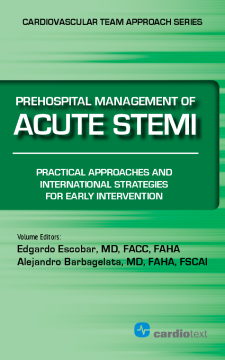
Additional Information
Book Details
Abstract
Prehospital Management of Acute STEMI: Practical Approaches and International Strategies for Early Intervention, the second volume in the Cardiovascular Team Approach Series, discusses the importance of coordinated prehospital care of STEMI with a practical focus on early detection and early intervention. Topics include:
ECG acquisition and STEMI specific interpretation
Telemedicine and regional triage centers
The increasingly important role of nurses and paramedic personnel
Additionally, gain an international perspective as authors from multiple countries discuss their experiences with diverse systems that manage prehospital STEMI recognition and care.
Doody Review Reviewer
Arnold Hite, MD, MS (Ochsner Clinic Foundation)
This book examines various systems and policies for STEMI (ST-elevation myocardial infarction) care and triage prior to arrival at the catheterization laboratory.
The purpose is to analyze the various strategies for prehospital STEMI management and weigh their pros and cons. With high variability in STEMI response systems in place across multiple countries, there is a need to determine which strategies are most effective. The book accomplishes this task with a systematic comparison approach to existing early STEMI protocols.
It is intended for those interested in healthcare systems, but would be most useful for administrators of emergency care and EMS care. The editors and authors are noted authorities on the topic.
This book provides details of the systems currently in place in STEMI care from the field to the emergency department, including emerging technologies and potential pitfalls. The first part of the book focuses on U.S. healthcare, while the second part discusses STEMI care around the world in a comparative fashion.
This will be a valuable resource to administrators of emergency care. Given its objective comparison of multiple systems and their interaction with laws and government standards, the book would be particularly useful for those in healthcare policy.
